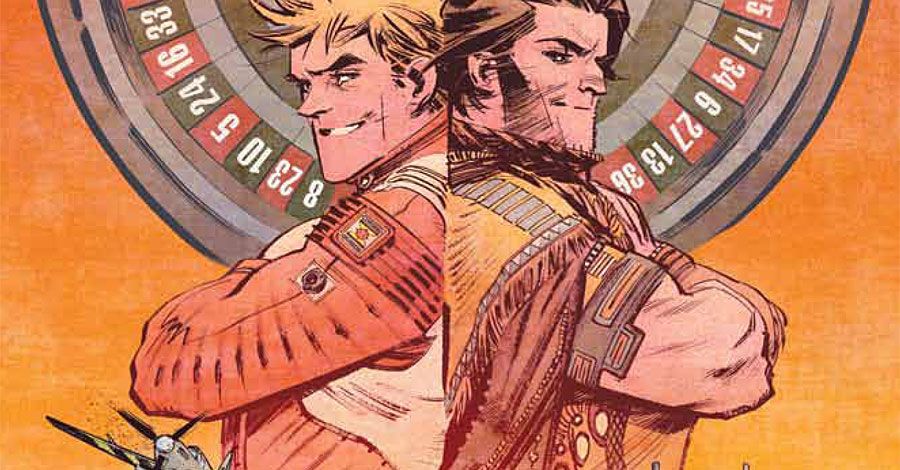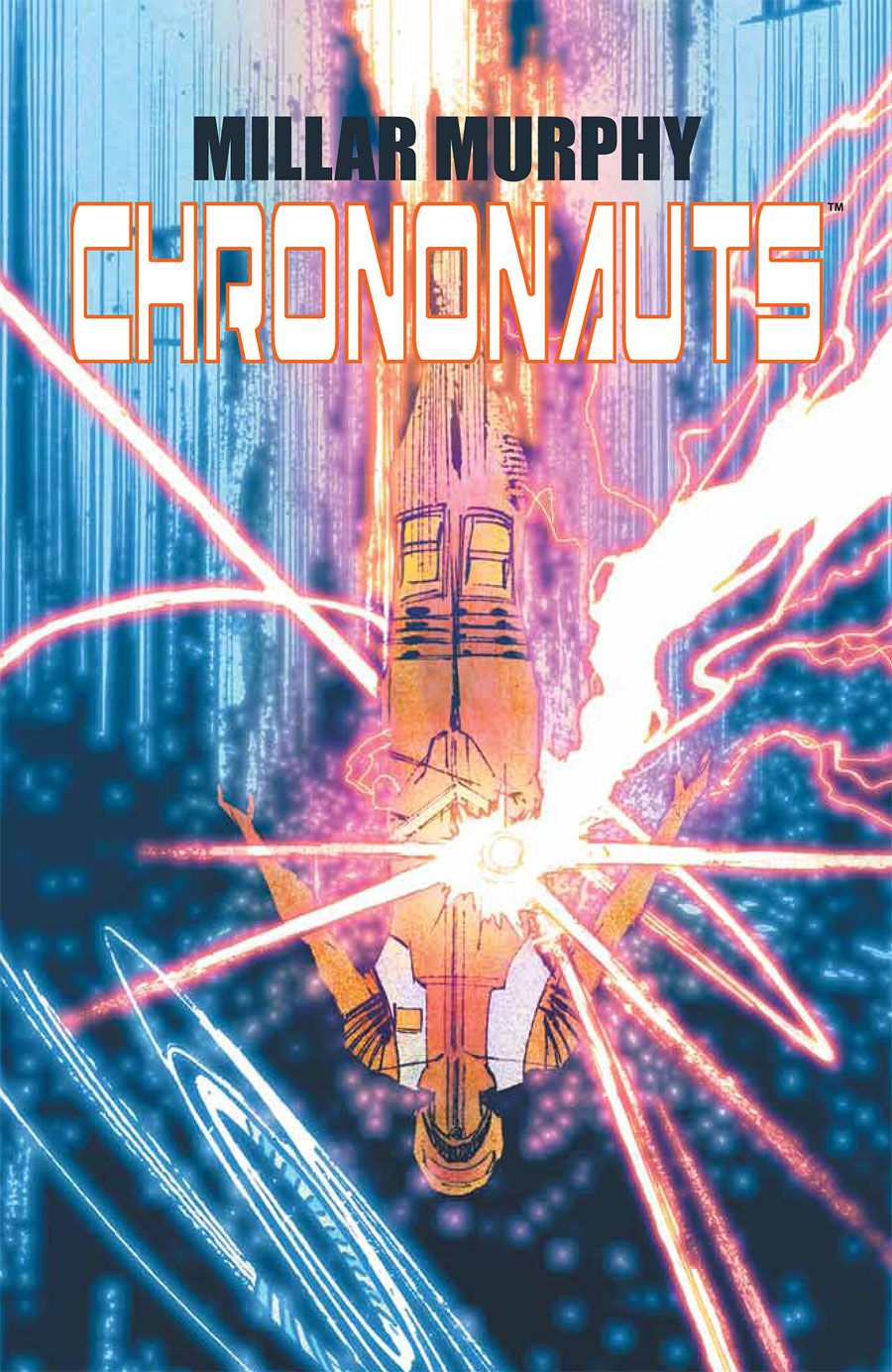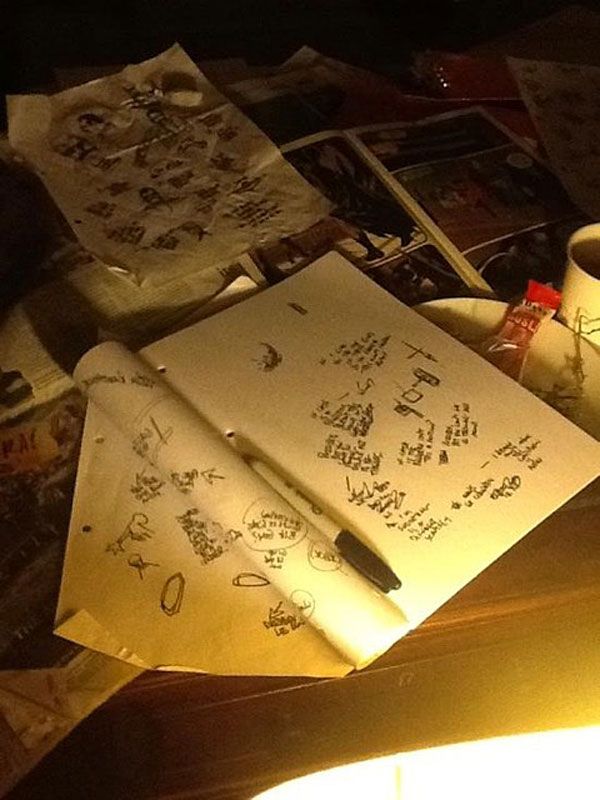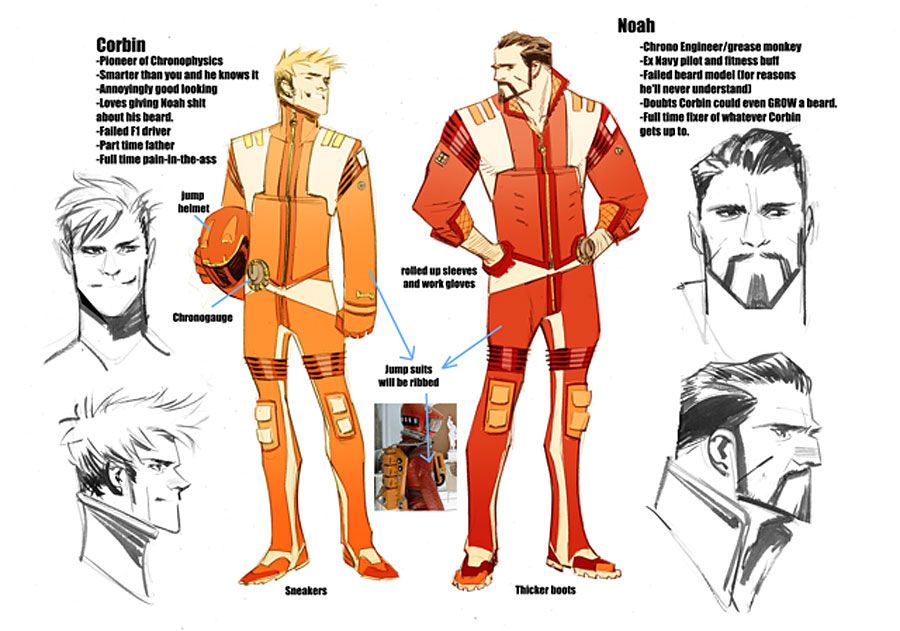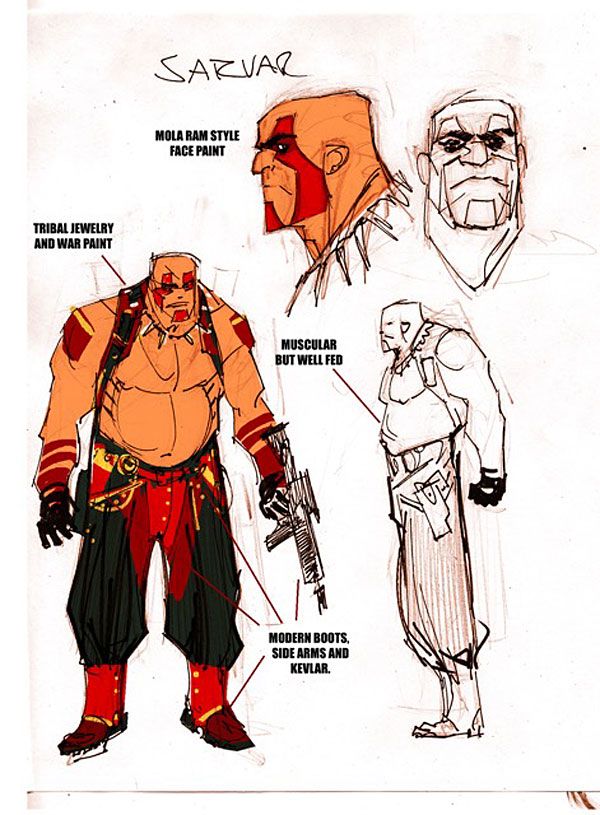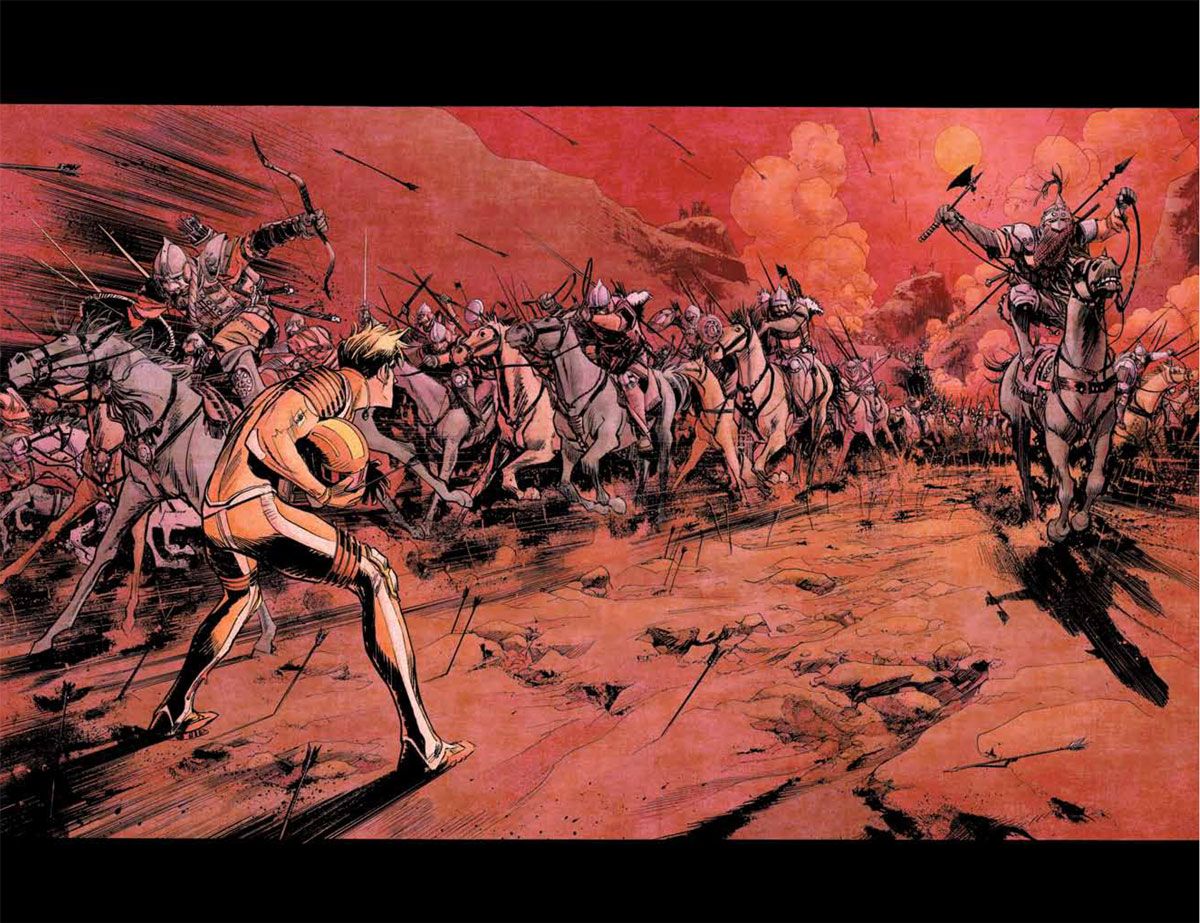Mark Millar has had plenty of success bringing his comics to Hollywood, but with his latest project, he kept the story secret from Tinseltown.
This week saw the release of "Chrononauts" Vol. 1, collecting the writer and Sean Gordon Murphy's time travel buddy comedy from Image Comics. But as Millar tells it, the series came about over a three year as he kept the story close to his chest rather than sign on a studio's dotted line before it was ready. A comics guy first and foremost, Millar is happy that he waited to present his story though the four-color medium first.
RELATED: Mark Millar Will Go Anywhere in the World to Sign "Jupiter's Circle"
During the course of our conversation, Millar shares the secret origin of "Chrononauts" with CBR, offers up his take on Hollywood's budget-focused flaws, shares details on 2016's sequel series (slated to arrive in the summer, with a forward-thinking twist) and teases how the stars of the Universal movie adaptation will arrive at the same time.
CBR News: Mark, you've talked before about how to plan out all your series in notebook form. With the collections coming out like "Chrononauts," have you ever thought about adding that stuff into the trade? I think it'd be fascinating to see your process soup-to-nuts.
Mark Millar: You know what? Just for fun, I'm going to send you some of them to run with the article so you can see why they're unpublishable. It looks like whenever the police have caught some guy, and they find a bunch of notes scribbled on the floor of the house where they discovered the bodies. [Laughter] That's my notes. They're incomprehensible.
I'll give you an example. Yesterday I was working on this sequence that's a big space battle, and the drawing that I did to help me concentrate while I was thinking of it was a mediaeval knight. I was just drawing some completely random thing in incredible detail. Whatever gets worked out of my head comes out on paper as something completely mental, but for me it make sense. I've got this little shorthand for all it. I'll send you a picture, and you'll say, "Why does this guy earn a living?"
But I do think it's interesting to see people's process. I'm fascinated by that. I want someone to do a book on writers and how we all work -- the hours we work, the process we have going from blank page to printed project. Because what's fascinating is how we're all completely different. My notes I really don't even have in a book. I draw them all on little scraps of paper, and then I lose some, and three months later I find things and try to reinsert it into the story. It's very chaotic, but it somehow kind of works.
I've got friends like Garth Ennis, who always has a little notebook on him that's about the size of a passport that he carries around in his jacket pocket. And then he neatly writes all his ideas down as they come to him. I've got other friends who get color-coded notepads for everything, so if they want to cross reference something with an idea they had in 1992, they just look it up on a flip chart.
When it comes to a series like "Chrononauts," are things set in stone before you start sending scripts off to Sean Murphy, or does the story really change as he becomes more a part of the process?
This is an unusual one, really, because the project predated Sean by about three or four years. It was going to be an entirely different medium. It was going to be a short film that I was going to write and direct. I typically find an artist who will suit the story. I never find an artist and then come up with a story just for them. It kind of feels wrong doing it that way. It's like someone saying, "Do you want to do a project with Tom Hardy?" and then you generate a project for him to star in. That doesn't seem like it works. I like the idea of finding the story and then finding the guy who can best tell the story. Like, nobody other than John Romita could have drawn "Kick-Ass." In 2006, I asked him if he wanted to do it, and he said, "Look, I've got 24 months of Marvel stuff to get done," and I said, "I'll wait, because you're the only artist I see in my head."
So the way "Chrononauts" came about was from Ridley Scott, believe it or not. Not to drop a huge name, but Ridley Scott asked me, about three years ago, if I wanted to direct a short science fiction film that he would be producing. They were going to be a whole series of downloadable, online movies that a video game company was financing. The thing ended up not happening, but it was supposed to be me and nine other new directors. He thought I might be good at it, and I'd never tried anything like that before. It was only 15 minutes, and the budget was $200,000 for a clever sci-fi idea. So "Chrononauts" is what I came up with. I'm glad it never got made that way, because now I realize that you could never make this for less than $150 or $200 million. It would have been the really cheap version! The idea was to do what I guess is now the first 15 or so pages of the comic. You'd have these guys sending the satellite back in time.
But it all came from there. Later, I had lunch with this guy from Universal and told him the idea, and he was like, "You should do it as a movie." I said that I didn't see it as a movie. I wanted to make it a comic. He said, "I'll buy it anyway." So I went off to do the comic first as my first love, and I asked Sean Murphy to get involved. And really, I couldn't have asked for a better partner. Sean has maybe been the best working experience I've had, maybe ever. Everybody I've worked with has done brilliant work, but they've also turned in something late here or there. Sean would send me five or six pages a week, which is phenomenal.
Especially considering how much he draws on every page.
It's insane! Every panel could be a poster. I don't know how he can maintain this, but he's doing it. He's coming back for "Chrononauts 2." We're starting it at the end of this year, around December, and it'll come out next summer. He's very, very professional. He has a huge calendar on the wall with all the dates he has to complete issues by, and he never complains. If I say to him, "Draw a castle in 1502 in the summertime in the Middle East," Sean will make it look exactly like it should. I don't know where he finds the reference. You can't exactly Google this stuff. But he's amazing.
Maybe he has a time machine.
[Laughs] I love the idea of having time travel and using it for really lame stuff like art reference. There's nothing worthy being done with it.
Do you do a lot of work on the design of things like the costumes the guys wear in the story, or the supporting characters and their look, or do you leave that completely up to your artist?
Some things are very clear in my head for exactly how they should look, and other times I just trust the artist. I'm really a bit of a perfectionist. I'll have an idea, and then I suggest it to the artist, and they maybe tweak it and add to it. Some guys just nail it the first time, and Sean is one of those guys. I had the idea for them wearing time suits because I like the idea of the time travel ability not being a car or a jetpack or something we've seen before. I wanted it to be something skin-tight that you could run around and jump around in. That's as much direction as I gave him, and Sean came back with the chronosuits, which was incredible.
So what can you say about the sequel? The book ends Corbin's story somewhat satisfyingly, but Reilly seems less so. My first thought was, "The next series has to be him going back in time to win the heart of Helen of Troy," or something like that. What can you say about what you're planning?
[Laughs] Actually, I'm thinking we're going to the future for the next one. If you notice, all of the time jumps you see take place before 2015. Every single jump was in history, but in the next one, every jump is into the future. I like the idea of a sequel being completely different than the first one. Jumping around the timestream again wouldn't have felt as special for a sequel, but this feels like completely uncharted territory. It feels a bit more like Buck Rogers, with two modern day guys going into the future, and that creates an entirely different kind of story.
It's funny. I was over at a friend's the other day, and we were scrolling through Netflix and "Quantum Leap" came up, and it occurred to us, "This sucks. He had the ability to jump anywhere in time, but the only places he ever went were in America between 1930 and 1970."
[Laughs] It's funny, but now having worked in film, I kind of get why things are always like that. They have to be cheap because they have no money. That's what I love about comics. When I was thinking about this as a low budget film, all we could afford to build was one set. You had to have everything else happening on monitors. The beauty of comics is that I can have a fourth-dimensional car chase that runs all the way through the timestream. You can get a bit of ancient Rome for only two panels because it doesn't cost anything. I get now the struggles of friends of mine who have worked on "Doctor Who." Because they can only afford to build one set per episode, so it's always something in the present day and then wherever the Doctor is traveling to. That's all the budget they have. This is why comics is a superior medium. We can do anything we like. Costumes and sets don't matter.
And is there any update on the "Chrononauts" movie?
Quite a few things are happening with that. My friend over at Universal was really keen to get it up and running. He said that it would be great for two big actors, and we got the guys we wanted. He always wanted to work with these guys, and it's something I never thought of working in comics, but if you have what they call a "double header" -- two big stars cast together -- it's such a cracking thing for your movie. It's really quite rare to have a Butch and Sundance kind of thing where you get two huge guys in one film. So this is our big sci-fi franchise with that idea, and hopefully we'll get a few movies out of it. It'd be cool. And so we got this writer who I'm friendly with who worked on the "Fast & The Furious" movies called Chris Morgan. Chris worked on "Wanted" with me, so I've known him since about 2006. It's great to be working with him again, and I'm going to LA in a month to meet with him. We're also going to have one of the actors meeting us in London soon. It's great, because it's two big actors who interestingly have each done a superhero movie before. They're two fan-favorite guys, and one of them is the hottest guy in town at the moment.
That makes it kind of hard to guess because you could throw a rock in Hollywood and hit five guys that have been superheroes at this point.
[Laughs] It's funny, because we're casting "Superior" at the moment, Matthew Vaughn and I. We were talking on the phone about this, and trying to find a female lead who hasn't already played a superhero's girlfriend is tough. Almost any big actress has already been Lois Lane or Mary Jane. You forget how many of these movies have been made in the past 15 years, so you really do need to snatch a newcomer just as they're coming up.
Do you know how close all the final details are to coming out? Does the studio just call you one day and say, "It'll be in the trades tomorrow"?
We have an organized plan. I know what we're planning with the schedule. We want to get both actors signed. One is signed already, and they're working with the other one even though he's formally agreed. The deal's just being done. We want to do something exciting, and it's fun to have two big names on a poster. It's funny. We were chatting, and we found this post from 1977 for the first "Superman" movie. They took this poster to Cannes, and it was the first time that they announced that Marlon Brando and Gene Hackman were going to be in "Superman." To have a poster at Cannes with their faces on it and the Superman logo was really exciting. So we're going to do something similar with "Chrononauts." It'll be both their names and faces on a poster for the announcement.
The "Chrononauts" collection is on sale now from Image Comics.

